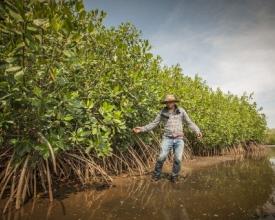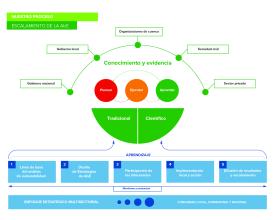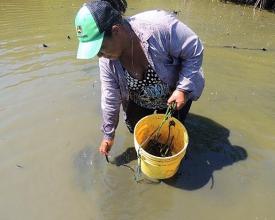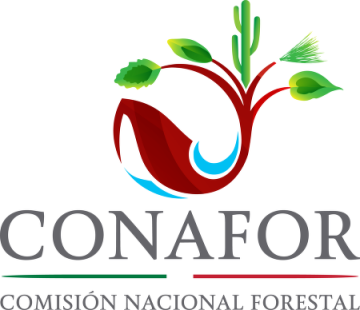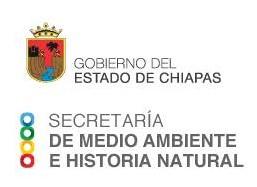
Restauration des mangroves pour la sécurité alimentaire dans la réserve côtière de l'État de Gancho Murillo, Chiapas, Mexique.

Afin de réduire la vulnérabilité au changement climatique des communautés de la côte de l'État du Chiapas, des mesures d'adaptation basées sur les écosystèmes (EbA) ont été mises en œuvre avec les communautés d'Ejido* Conquista Campesina, situées dans la zone de Gancho Murillo sujette à la conservation écologique (réserve d'État).
Ces mesures visaient à sensibiliser à la valeur des mangroves et à améliorer leur état grâce à des actions de restauration. Le dégagement des canaux d'eau a permis à l'eau de s'écouler et d'augmenter la zone de pêche globale, ce qui a bénéficié à la résilience sociale et à la sécurité alimentaire des communautés. Le travail avec les communautés de pêcheurs a impliqué une approche d'"apprentissage par l'action", qui a permis à la communauté de participer activement, de s'approprier les mesures d'EbA et d'évaluer l'efficacité de la protection des moyens de subsistance locaux. Cela a permis de renforcer la cohésion sociale des communautés, la gouvernance locale, les relations institutionnelles et la capacité de plaidoyer des dirigeants.
*Ejido : structure communale de propriété foncière au Mexique
Contexte
Défis à relever
- La déforestation dans la partie supérieure du bassin versant de la rivière Cahoacán génère de l'érosion et diminue la capacité d'infiltration de l'eau dans le sol, ce qui, combiné à des changements dans la configuration et l'intensité des précipitations, augmente le ruissellement et le dépôt de sédiments dans les écosystèmes côtiers en aval.
- Conquista Campesina possède 828 ha de terres communes comprenant des écosystèmes de mangrove, qui sont menacés par le taux élevé de déforestation (résultant de l'expansion de la frontière agricole et de l'exploitation forestière illégale), ainsi que par une sédimentation excessive (envasement). Cette sédimentation nuit non seulement aux mangroves, mais contribue également aux fréquentes inondations des villages.
- L'avancée des eaux salines due à l'intrusion de l'eau côtière dans la zone humide génère un déséquilibre écologique qui affecte la régénération naturelle de la mangrove et réduit la qualité de l'eau pour la consommation humaine.
- Les organes de représentation et les dirigeants de l'assemblée ejidale ont besoin d'une plus grande capacité de plaidoyer politique auprès des entités gouvernementales.
Emplacement
Traiter
Résumé du processus
Cette solution pour un ejido côtier au Chiapas est présentée à travers 3 Building Blocks (BB) : 1. apprentissage par l'action, 2. résilience socio-environnementale, et 3. Gouvernance.
La mise en œuvre des mesures d'EbA (BB2) et la gouvernance pour l'adaptation (BB3) sont réalisées en mobilisant le soutien des structures communautaires dans le cadre d'une approche d'apprentissage par l'action (BB1) qui combine la formation, les actions de terrain (restauration, surveillance, diversification productive), la participation, le suivi et l'évaluation des services écosystémiques de la mangrove. Les actions de restauration améliorent l'état de conservation des écosystèmes de mangrove, avec des résultats directs pour les moyens de subsistance locaux (pêche, collecte) et la réduction des risques de catastrophes basée sur l'écosystème. La restauration a prouvé qu'elle augmentait la résilience à la variabilité climatique et qu'elle diminuait l'insécurité alimentaire. Au niveau communautaire, un processus d'apprentissage collectif et d'autonomisation s'ensuit, avec l'acquisition de connaissances techniques, conduisant à des progrès dans la gouvernance de l'ejido et dans sa capacité de plaidoyer politique, d'élargissement et d'accès aux ressources financières, ainsi qu'au renforcement de sa capacité d'adaptation. Des contributions sont également apportées à la bonne gouvernance de la zone côtière en créant une coopération entre les agences locales, étatiques et fédérales.
Blocs de construction
Apprentissage par l'action" et suivi pour accroître les capacités et les connaissances
L'aide apportée aux membres de la communauté de l'ejido pour mettre en œuvre les mesures d'EbA génère un processus d'"apprentissage par l'action" qui, en plus de l'enseignement, vise à produire des preuves des avantages de l'EbA et à créer les conditions de leur durabilité et de leur mise à l'échelle.
- Évaluation communautaire des risques CRiSTAL
- La restauration de la mangrove (4,1 ha) et la surveillance sont considérées comme des mesures prioritaires de l'EbA.
- Un soutien technique est fourni à 33 membres de la communauté (hommes et femmes), complété par leurs connaissances traditionnelles, pour apprendre les techniques de restauration de la mangrove et procéder à la restauration des zones dégradées.
- 5 techniciens communautaires sont formés au suivi et à l'évaluation des zones restaurées (mesures du diamètre des arbres, des paramètres physico-chimiques et des sédiments).
- Le suivi et l'évaluation sont effectués pour connaître la sécurité alimentaire de 10 familles(échantillon) et étudier les avantages de la restauration sur les moyens de subsistance pendant la saison sèche et la saison des pluies. Des enquêtes sociales auprès des ménages sont utilisées comme méthodologie (lignes directrices à publier).
- Apprentissage conjoint des avantages de la diversification des revenus, tels que les jardins (vergers), l'agroforesterie et l'apiculture.
L'augmentation des capacités et des connaissances renforce le capital humain et contribue à l'autonomisation des communautés et, par conséquent, à l'accroissement des possibilités de plaidoyer politique et d'accès aux ressources financières.
Facteurs favorables
- Certains membres de l'ejido de Conquista Campesina avaient déjà travaillé avec de bonnes pratiques de gestion écologique et/ou avaient participé au programme local de paiement pour services environnementaux (coordonné par Pronatura Sur A.C. et CONAFOR). Cela a facilité l'acceptation des actions de restauration par les membres de la communauté.
Leçon apprise
- Lors de la mise en œuvre du suivi et de l'évaluation de la sécurité alimentaire et de son amélioration par l'EbA, de nombreux membres de l'ejido ont réalisé qu'il était important de gérer leur territoire de manière intégrale et de ne pas se contenter d'assurer la protection, la conservation et la restauration des mangroves. Cela a éveillé l'intérêt pour la diversification des cultures utilisées dans les parcelles familiales, et la compréhension que cette mesure améliorerait l'alimentation des familles et augmenterait les sources de revenus.
Renforcement de la résilience environnementale et sociale grâce à la restauration de la mangrove
L'ejido Conquista Campesina souhaitait restaurer les forêts de mangroves et les services écosystémiques qu'elles fournissent (diversité biologique, qualité de l'eau, protection contre les tempêtes) en vue de renforcer sa sécurité alimentaire et sa résilience face au changement climatique.
L'ouverture de canaux hydrologiques a d'abord été réalisée pour réalimenter en eau les zones endommagées par la sédimentation, puis la collecte, la translocation et l'ensemencement de propagules dans les zones dégradées ont été coordonnés. Grâce au "paiement des journées de travail" en tant qu'incitation à la restauration (paiement des services environnementaux), ces efforts ont également eu des retombées économiques pour la communauté. Alors que la surface de l'eau a été améliorée dans les zones de pêche, la communauté s'est également protégée contre les vents et les ondes de tempête dans les zones utilisées pour la collecte, la pêche et le logement. En outre, des jardins familiaux (vergers), l'agroforesterie et l'apiculture ont été mis en place dans certaines parcelles afin de diversifier les produits utilisés par les familles pour l'autoconsommation. Ces processus ont constitué d'importants moyens d'apprentissage pour les membres de l'ejido, hommes et femmes, qui ont acquis des connaissances techniques (sur la restauration des mangroves et la gestion des plantes en association) et une meilleure compréhension de la relation entre le changement climatique, la conservation et la sécurité alimentaire.
Facteurs favorables
- Les assemblées d'ejidos sont des institutions très fortes au sein des communautés de l'État du Chiapas. Leur autorité et leurs décisions sont essentielles à l'adoption de toute mesure de gestion de l'écosystème. L'approbation de l'assemblée est synonyme de soutien de l'ensemble de la communauté.
- Il existe un système local de paiement pour les services environnementaux (par le biais de fonds concurrents et coordonné par Pronatura Sur A.C. et CONAFOR) qui soutient la restauration, la protection et la surveillance des écosystèmes de mangrove (~500 ha au total).
Leçon apprise
- La possibilité d'accéder à une incitation économique, sous la forme de "paiements pour les jours de travail", a été une source de motivation et un moyen efficace de restaurer 4,1 ha de forêt de mangrove à Conquista Campesina.
- Les efforts de restauration ont éveillé l'intérêt des membres de l'ejido pour d'autres possibilités telles que la mise en place de jardins familiaux (vergers), l'agroforesterie et l'apiculture sur leurs parcelles. Ces changements (l'acquisition de nouvelles connaissances et de produits pour l'autoconsommation) se sont avérés convaincants pour les familles, car ils pourraient réduire leur dépendance à l'égard de la pêche et des écosystèmes de mangrove.
Renforcer la gouvernance pour l'adaptation
Au sein des structures communautaires de l'ejido, l'assemblée de l'ejido fait office de plateforme de gouvernance et constitue l'organe de décision le plus élevé. L'obtention de l'approbation de l'assemblée a été une étape clé dans le lancement et l'intensification des efforts de restauration de la mangrove dans l'ejido de Conquista Campesina. Un programme communautaire a été élaboré pour la conservation des zones humides et des systèmes aquatiques grâce à la conservation volontaire de terres désignées comme "servitudes écologiques". Grâce à son travail autour des mangroves, l'organisation de l'ejido s'est améliorée et a généré davantage de liens institutionnels, tant avec l'État qu'avec les autorités fédérales. Cela ouvre également des possibilités de faire remonter les besoins d'adaptation à des niveaux de gouvernement plus élevés. Dans cette optique de plaidoyer politique, les membres de l'ejido ont participé au VIIe Congrès national sur la recherche en matière de changement climatique, parrainé par le Conseil consultatif sur le changement climatique du Chiapas, récemment réactivé, afin de présenter les avantages de l'EbA ainsi que des propositions pour que leurs priorités soient prises en compte dans la politique de l'État en matière de changement climatique. L'aide apportée à l'organisation sociale de l'ejido a donc contribué à renforcer la gouvernance en matière d'adaptation au changement climatique, du niveau local au niveau de l'État.
Facteurs favorables
- Le soutien de l'assemblée de l'ejido favorise la mise en œuvre et le suivi (M&E) des mesures EbA. Il s'agit d'une recherche sociale avec des enquêtes auprès des ménages qui doit être appliquée pendant la saison des pluies et la saison sèche.
- Le Congrès national sur la recherche en matière de changement climatique, auquel participe le Conseil consultatif sur le changement climatique du Chiapas, récemment réactivé, offre aux parties prenantes, telles que les ejidos, la possibilité de présenter leurs besoins et leurs propositions en matière de changement climatique à différentes entités de l'État.
Leçon apprise
- L'organisation de l'ejido et le soutien technique ont été déterminants pour la mise en œuvre des actions de restauration et de surveillance, ainsi que pour l'adoption d'accords, l'extension de l'EbA et l'accès à des ressources financières dans le cadre de programmes fédéraux (paiement des services environnementaux de la CONAFOR).
- Compte tenu de la mosaïque de régimes de propriété existant sur la côte du Chiapas, les meilleures solutions pour protéger les services écosystémiques côtiers et les moyens de subsistance locaux sont celles qui découlent des mécanismes de conservation dont la principale force motrice est la participation active et l'autonomisation des utilisateurs et des propriétaires des ressources naturelles.
Impacts
- Meilleure connaissance de la restauration et de la gestion durable des mangroves.
- Restauration de 25 ha depuis 2011
- Reboisement de 4,1 ha de mangroves
- Prévention de l'abattage illégal par la surveillance
- Récupération et dégagement du système hydrologique de la mangrove grâce au dégagement de 180m de canaux d'eau permettant à l'eau de mieux circuler le long de l'estuaire, favorisant l'entrée de l'eau de mer et la reproduction des poissons à écailles, des crevettes et d'autres espèces.
- Durabilité des actions : la prise de décision au niveau local a permis d'accroître les efforts dans la région.
- Avantages économiques grâce à des mesures d'incitation dans le domaine de la sylviculture, en utilisant la modalité du "paiement des journées de travail" liée aux efforts de restauration.
- Recherche sur les bénéfices de l'EbA pour la sécurité alimentaire en utilisant une méthodologie de suivi et d'évaluation avec les familles locales.
- Sensibilisation politique avec la présentation au niveau de l'État des priorités de l'EbA et de l'étude de vulnérabilité de l'ejido* Conquista Campesina.
Remarque : dans les structures de gouvernance du Chiapas, l'ejido est la principale plateforme sociale où sont prises les décisions participatives concernant les ressources naturelles. Le régime foncier de l 'Ejido au Mexique est un exemple de régime foncier individuel et communal coexistant au sein des communautés. Les terres communales sont titrées au nom des dirigeants de la communauté.
Bénéficiaires
- Directs : 420 habitants de l'ejido Conquista Campesina, avec 33 membres de la communauté formés à la restauration et à la surveillance des mangroves.
- Indirecte : 3 communautés environnantes (ejidos Barra de Cahoacán, Brisas del Mar et La Cigüeña).
- Municipalité de Tapachula
Objectifs de développement durable
Histoire

L'ejido côtier Conquista Campesina est l'un des neuf ejidos présents dans la réserve d'État de Gancho Murillo (zone de conservation écologique), où il reste encore 7 284 ha de mangrove (contre environ 132 000 ha dans l'État du Chiapas). Bien qu'elle soit protégée, la zone est densément peuplée de ranchs, de communautés et de pêcheries. Les moyens de subsistance les plus courants sont la pêche et l'extraction du bois, qui est particulièrement importante pour la sécurité alimentaire des familles.
Les écosystèmes de mangrove sont menacés par plusieurs facteurs. Les taux élevés de déforestation dans le bassin de la rivière Cahoacán, qui alimente en eau la zone côtière de Conquista Campesina et ses mangroves, et les effets de la variabilité climatique, en particulier les précipitations excessives qui augmentent le ruissellement et le dépôt de sédiments en aval du bassin. En outre, l'augmentation de la sédimentation contribue aux inondations fréquentes des communautés, tandis que les ondes de tempête côtières mettent également en danger les habitations et les zones de pêche. La salinisation croissante des puits d'eau due à l'augmentation de la fréquence des tempêtes et à d'autres risques côtiers, qui assurent l'approvisionnement en eau des communautés côtières, est également un problème.
La santé et la régénération des mangroves pour protéger les communautés côtières ont constitué un aspect essentiel de la recherche de solutions à cet ensemble de défis. En tant que mesure d'EbA, les communautés de Conquista Campesina ont soutenu des mangroves plus saines qui fourniraient de la nourriture, des moyens de subsistance, une protection contre les ouragans et un refuge pour les espèces de pêche. Lancement du projet de restauration de la mangrove dans l'ejido, qui a finalement apporté, outre l'adaptation au changement climatique et la réduction des risques de catastrophe, divers avantages économiques, sociaux et environnementaux à la population de Conquista Campesina et, dans une certaine mesure, aux ejidos voisins également.
M. Cándido González Nafaté, membre de la communauté technique de l'ejido Conquista Campesina, mentionne l'importance de promouvoir le renforcement de l'organisation sociale et de la gouvernance territoriale de l'ejido lors de la définition des mesures d'adaptation (restauration de la mangrove), et valorise les aspects de la participation, de la responsabilité, de la transparence, de l'efficacité et de l'inclusivité. Afin de réduire l'énorme pression qui pèse sur les ressources naturelles de la région, il propose de créer les conditions nécessaires pour aider les propriétaires de terres forestières en amont à entreprendre des processus de valorisation de leurs matières premières, en rappelant que ces propriétaires appartiennent également à des communautés très marginalisées dans le bassin.
